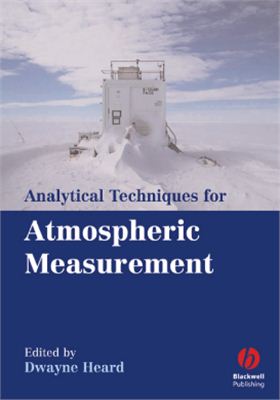Blackwell Publishing Ltd, 2006, 533 pp. - ISBN-13:
978-1-4051-2357-0
In almost all of the scientific jouals where data from field measurements are presented, it is the results, and how they have advanced our understanding of our complex workings of the atmosphere, that have received the most attention. We must not forget, however, that the instruments making the measurements are themselves state-of-the-art and highly specialised, having been first developed in the laboratory by chemists, physicists or engineers, before being applied to the measurement of atmospheric composition. There is usually insufficient space in the joual articles for a thorough description of the instrument, and often only essential details are given. Although there are a number of jouals that specialise in the description of instruments, for example Review of Scientific Instruments, there is no common theme to a given issue, and an instrument to measure an important atmospheric constituent will likely be sandwiched between articles covering instruments from unrelated fields.
Contents
Preface.
Field Measurements of Atmospheric Composition – (Dwayne E. Heard).
Infrared Absorption Spectroscopy – (Alan Fried and Dirk Richter).
UV-Visible Differential Optical Absorption Spectroscopy (DOAS) – (John M.C. Plane and Alfonso Saiz-Lopez).
Fluorescence Methods – (Ezra C. Wood and Ronald C. Cohen).
Mass Spectrometric Methods for Atmospheric Trace Gases – (Jonathan Williams).
Mass Spectrometric Methods for Aerosol Composition Measurements – (Hugh Сое and James D. Allan).
Chemical Methods: Chemiluminescence, Chemical Amplification, Electrochemistry, and Derivatization – (Andrew J. Weinheimer)
Chromatographic Methods – (Jacqueline F. Hamilton and Alastair C. Lewis).
Measurement of Photolysis Frequencies in the Atmosphere – (Andreas Hofzumahaus).
Appendix.
References.
Index
In almost all of the scientific jouals where data from field measurements are presented, it is the results, and how they have advanced our understanding of our complex workings of the atmosphere, that have received the most attention. We must not forget, however, that the instruments making the measurements are themselves state-of-the-art and highly specialised, having been first developed in the laboratory by chemists, physicists or engineers, before being applied to the measurement of atmospheric composition. There is usually insufficient space in the joual articles for a thorough description of the instrument, and often only essential details are given. Although there are a number of jouals that specialise in the description of instruments, for example Review of Scientific Instruments, there is no common theme to a given issue, and an instrument to measure an important atmospheric constituent will likely be sandwiched between articles covering instruments from unrelated fields.
Contents
Preface.
Field Measurements of Atmospheric Composition – (Dwayne E. Heard).
Infrared Absorption Spectroscopy – (Alan Fried and Dirk Richter).
UV-Visible Differential Optical Absorption Spectroscopy (DOAS) – (John M.C. Plane and Alfonso Saiz-Lopez).
Fluorescence Methods – (Ezra C. Wood and Ronald C. Cohen).
Mass Spectrometric Methods for Atmospheric Trace Gases – (Jonathan Williams).
Mass Spectrometric Methods for Aerosol Composition Measurements – (Hugh Сое and James D. Allan).
Chemical Methods: Chemiluminescence, Chemical Amplification, Electrochemistry, and Derivatization – (Andrew J. Weinheimer)
Chromatographic Methods – (Jacqueline F. Hamilton and Alastair C. Lewis).
Measurement of Photolysis Frequencies in the Atmosphere – (Andreas Hofzumahaus).
Appendix.
References.
Index

